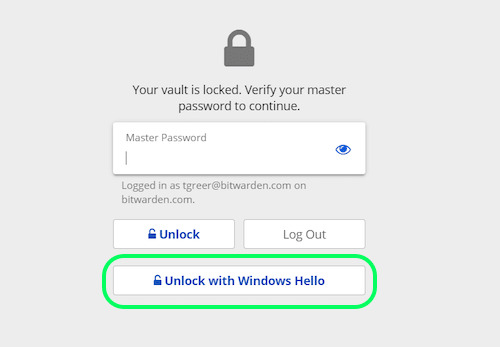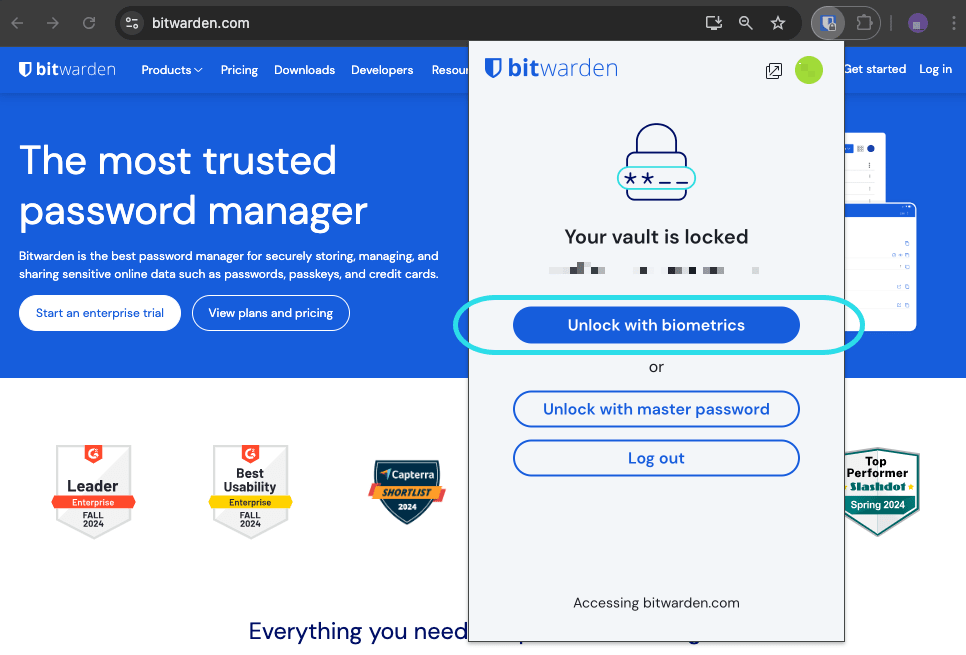Unlock with Biometrics
Bitwarden can be configured to accept biometrics as a method to unlock your vault.
Biometrics can only be used to unlock your vault, you will still be required to use your master password or login with device, and any enabled two-step login method when you log in. Unlock with Biometrics is not a feature designed to be a passwordless login, if you are not sure of the difference, see Understanding unlock vs. log in.
tip
Biometric features are part of the built-in security in your device and/or operating system. Bitwarden leverages native APIs to perform this validation, and therefore Bitwarden does not receive any biometrics information from the device.
Unlock with biometrics can be enabled for Bitwarden on mobile, desktop, and browser extensions:
Enable for mobile
Unlock with biometrics is supported for Android (Google Play or FDroid) via fingerprint unlock or face unlock, and for iOS via Touch ID and Face ID.
To enable unlock with biometrics for your mobile device:
In your device's native settings (e.g. the iOS Settings app), make sure your biometric method is turned on.
In your Bitwarden app, open the Settings tab.
Open the Account security section and tap the biometrics option you want to enable. What's available on this screen is determined by your device's hardware capabilities and what you have enabled (step one), for example:

Tapping the option will prompt you to input your biometric (for example, face or thumb-print). The toggle will fill in when unlock with biometrics is successfully enabled.
Disabled pending master password verification
If you get a message reporting that biometric unlock is disabled for auto-fill pending verification of your master password:
Temporarily turn off auto-fill in Bitwarden.
Re-enable biometrics in Bitwarden.
Turn auto-fill back on in Bitwarden.
Enable for desktop
Unlock with biometrics is supported for Windows via Windows Hello using PIN, Facial Recognition, or other hardware that meets Windows Hello biometric requirements and for macOS via Touch ID and for Linux with system authentication.
Unlock with biometrics is set separately for each account logged in to the desktop app. To enable unlock with biometrics:
In your device's native settings (for example, the macOS System Preferences app), make sure your biometric method is turned on.
tip
Windows users may need to install the Microsoft Visual C++ Redistributable before Windows Hello can be turned on in desktop preferences.
In your Bitwarden app, open your Settings (on Windows or Linux, File → Settings) (on macOS, Bitwarden → Preferences).
In the security section, select the biometric option you want to enable. What's available on this screen is determined by your device's hardware capabilities and what you've turned on (step 1). On Linux, this will always be Unlock with system authentication. Example:

Unlock with Windows Hello Optionally, select either the Require password (or PIN) on app start or Ask for biometric on app start option to set how your desktop app will behave when you start the the app.
tip
If you're using Windows, Bitwarden recommends using the Require password (or PIN) on first login after start in order to maximize security.
If you select neither option, you can simply select the Unlock with biometric button on the login screen to prompt for your biometric option:

Ontgrendelen met Windows Hello
About Biometrics in browser extensions
Unlock with biometrics is supported for extensions through an integration with the Bitwarden desktop app. In practical terms, this means:
For all browser extensions, you will need to enable unlock with biometrics in desktop before proceeding. For all except Safari, the Bitwarden desktop app must be logged in and running in order to use unlock with biometrics for a browser extension.
Browser extensions support the same biometrics options as desktop; for Windows via Windows Hello using PIN, Facial Recognition, or other hardware that meets Windows Hello biometric requirements, for macOS via Touch ID, and for Linux (Chromium-based browsers only) with system authentication.
Two things to bear in mind before enabling the integration are Permissions and Supportability, documented below:
Permissions
To facilitate this integration, browser extensions except Safari will ask you to accept a new permission for Bitwarden to communicate with cooperating native applications. This permission is safe, but optional, and will enable the integration that is required to enable unlock with biometrics.
Declining this permission will allow you to use the browser extension as normal, without unlock with biometrics functionality.
Supportability
Unlock with biometrics is supported for extensions on Chromium-based browsers (Chrome, Edge, Opera, Brave, and more), Firefox 87+, and Safari 14+. Unlock with biometrics is currently not supported for:
Firefox ESR (Firefox v87+ will work).
Microsoft App Store desktop apps (a side-loaded Windows desktop app, available at bitwarden.com/download will work fine).
Side-loaded MacOS desktop apps (an App Store desktop app will work fine).
Enable for browser extensions
To enable unlock with biometrics for your browser extension:
tip
Biometrics (Windows Hello or Touch Id) must be enabled in your desktop app before proceeding. If you don't see the Windows Hello option in your desktop app, you may need to install the Microsoft Visual C++ Redistributable. Additionally, if you are using Safari, you can skip straight to step 4.
In your Bitwarden desktop app, navigate to settings (on Windows, File → Settings) (on macOS, Bitwarden → Settings).
Scroll down to the options section, and check the Allow browser integration box.
noot
Optionally, check the Require verification for browser integration option to require a unique fingerprint verification step when you activate the integration.
In your Browser, navigate to the extensions manager (e.g.
chrome://extensionsorbrave://extensions), open Bitwarden, and toggle the Allow access to file URLs option.Not all browsers will require this to be toggled on, so feel free to skip this step and circle back to it only if the remaining procedure doesn't work.
In your browser extension, open the Settings tab.
Select Account security and check the Unlock with biometrics box.
tip
You may be prompted at this stage to allow Bitwarden to
communicate with cooperating native applications. This permission is safe, but optional and solely enables the browser extension to communicate with desktop as described above.You will be prompted by your desktop app to input your biometric. Doing so will complete the initial setup procedure. If you have opted to require verification (step two), you will need to approve a fingerprint validation check.
If you want the browser extension to automatically prompt for your biometric input when launched, make sure the Prompt for biometrics on launch option is on.
The browser extension will automatically prompt for your biometric when you open it. If you turn the prompt option off (step six), use the Unlock with biometrics button on the Unlock screen:

tip
Your desktop app needs to be logged-in and unlocked in order to unlock a browser extension with biometrics.
Disabled pending master password verification
If you get a message reporting that biometric unlock is disabled for auto-fill pending verification of your master password:
Temporarily turn off auto-fill in Bitwarden.
Re-enable biometrics in Bitwarden.
Turn auto-fill back on in Bitwarden.
In order to understand why unlocking and logging in are not the same, it's important to remember that Bitwarden never stores unencrypted data on its servers. When your vault is neither unlocked nor logged in, your vault data only exists on the server in its encrypted form.
Logging in to Bitwarden retrieves the encrypted vault data and decrypts the vault data locally on your device. In practice, that means two things:
Logging in will always require you to use your master password or login with device to gain access to the account encryption key that will be needed to decrypt vault data.
This stage is also where any enabled two-step login methods will be required.Logging in will always require you to be connected to the internet (or, if you are self-hosting, connected to the server) to download the encrypted vault to disk, which will subsequently be decrypted in your device's memory.
Unlocking can only be done when you are already logged in. This means, according to the above section, your device has encrypted vault data stored on disk. In practice, this means two things:
You don't specifically need your master password. While your master password can be used to unlock your vault, so can other methods like PIN codes and biometrics.
noot
When you setup a PIN or biometrics, a new encryption key derived from the PIN or biometric factor is used to encrypt the account encryption key, which you will have access to by virtue of being logged in, and stored on disk
ª.Unlocking your vault causes the PIN or biometric key to decrypt the account encryption key in memory. The decrypted account encryption key is then used to decrypt all vault data in memory.
Locking your vault causes all decrypted vault data, including the decrypted account encryption key, to be deleted.
ª- If you use the Lock with master password on restart option, this key is only stored in memory rather than on disk.You don't need to be connected to the internet (or, if you are self-hosting, connected to the server).
Suggest changes to this page
How can we improve this page for you?
For technical, billing, and product questions, please contact support